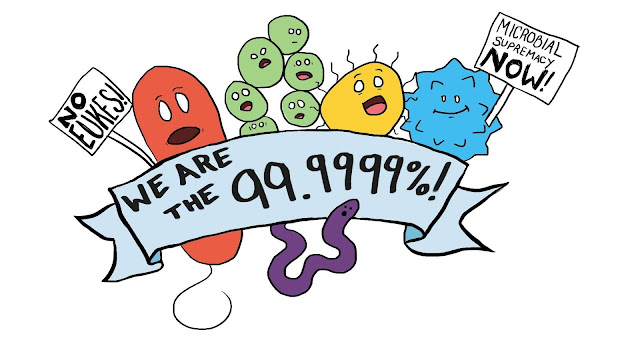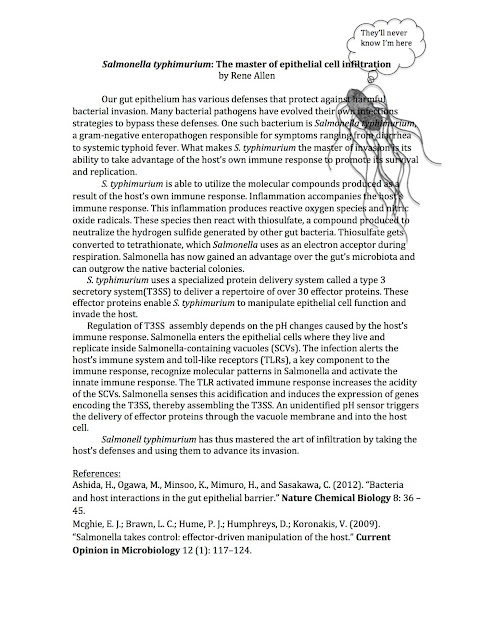On the other side of the lectern, I am here to tell you that it is very true: we don't enjoy giving exams (well, and we enjoy grading them even less). We indeed don't think a student's performance on a test measures much other than how much they studied.
When my sons were younger, I would ask them what a test was intended to measure.
"What you learned in class?" they promptly replied.
But that would be a long, long test, I reminded my sons (and I remind my students of that when they ask). All a test really does, friends and neighbors, is measure how hard you studied consistently. That is a valuable measure, but imperfect.
Over the years, I have found that students learn best when there exists ownership on their part. The student selects the term paper topic. The student comes up with a challenging question. Ownership works.
In my Fall semester Microbiology course here at the University of Puget Sound, I have seventeen brave micronauts to whom I preach the One True Microbial Faith™.
Test times can be challenging. First, I have a mascot (from Micropia, the microbiology museum in Amsterdam) encouraging them.
Next, I feed them. Too much grease from McDonald's hash browns this time, I suspect. But they are young, and have remarkable metabolisms.
I then hand out "Comfort Microbes" from GiantMicrobes to relax the students during test taking.
 |
| Emily with MRSA |
 |
| Juniper cuddles up to Chlamydia |
 |
| Carly gets to know Campylobacter |
 |
| Anne lives tough with a tardigrade pillow. |
 |
| Renee and the Zika virus have a special moment |
 |
| Erin gently holds an old student made Bdellovibrio, which is now sadly falling apart. |
 |
| Trini and Salmonella were meant for each other. |
 |
| Molly and staphylococcus seem of one mind. |
 |
| Josh and his Treponema get to work (sssh---don't call Treponema syphilis) |
On this exam, I asked my micronauts to illustrate with a cartoon (and hopefully some humor) one of the concepts we discussed in class since the first exam. In the past, I have found this approach has interesting effects: it encourages deep and integrative thinking, the "new" approach shakes up the student brain, and I learn fascinating insights into my class, and the student mind.
Here is what my micronauts came up with on Exam #2. Enjoy!
One of the concepts I repeated many times during the "microbial metabolism" portion of my course is the role that precursor metabolites play. PMs are the "common metabolic language" all living things "speak."
Recently in class, my I discussed with my micronauts the idea from Carl Zimmer's fine essay "The Human Lake" that we humans are a series of ecological niches in which microbes can adapt and prosper. Walking ecologies, we are!
Thought we didn't have a lot of time to discuss it, I always enjoy telling students about giruses in general, and in particular the discovery of the mimiviruses, including the origin of their name as microbe mimicking viruses! Viruses with more DNA than many bacteria, and visible under the light microscope...well, it helps micronauts see that my beloved microbiology is not simple!
During my short sessions on virology, I do speak a bit about influenza. The concept of antigenic shift seems to stay with students effectively.
Now this one was interesting! The cartoon is based on phenotypic complementation/synergism observed in our lab when two Serratia marcescens mutants blocked at different steps of prodigiosin synthesis are streaked near to one another.
We see this phenomenon each year during the genetics portion of the microbiology lab, and students always find it pretty interesting.
So the cartoon makes sense. Including the "prodiawesome" pun.
I often tell my micronauts to think about gene regulation of the organisms in our gut---expression of various catabolic genes must change quickly during our meals. So here we go from being "hangry" to being well-regulated!
Speaking of regulation, the way negative regulation of the tryptophan operon in E. coli works reminded one student of the relationship between TrpR and the co-repressor tryptophan.
The Rainey and Travisano paper showing "adaptive radiation" of Pseudomonas syringae in small glass tubes is a conceptual winner, year after year. The Hand of Darwin is on us all, and evolution can take place during cultivation of bacteria!
This led one of my students to, um, some dark places.
We also discussed how horizontal gene transfer impacted interactive and operational genes during lecture. The concept was on the following student's mind!
I was very glad to see that at least one student shared my fascination with riboswitches. Adding cis and trans effects to the mix only made me happier.
I consider Rubisco and nitrogenase to be the two most important enzymes on the planet (fixing carbon and fixing nitrogen). In this cartoon, the student links the course paradigm of compartmentalization to the toxic effects of oxygen on nitrogenase. In this case, a heterocyst from a cyanobacterium mixed in with a bit of Harry Potter!
When I teach my micronauts about precursor metabolites, I remind them that when we eat a steak, we don't just plop the steak onto our arms and have it fuse muscle tissue to muscle tissue. Instead, we break down the steak to protein to amino acids, and then build things up again with that common metabolic language of PMs.
This clearly had an impact on one student, in a holiday relevant fashion.
No exam can cover every topic discussed during lecture (nor would any student want to take such an exam!). So I was quite pleased with this one. At one point during the evolution portion of the course, I had the students read a bit about the elusive Lokiarchaeta, which may be the ancestor of every eukaryotic cell. One reason, according to the reading, was the presumptive flexibility of the cell membrane, allowing this early cell to carry out endocytosis (something there is little evidence for among bacteria and archaea). But endocytosis is absolutely necessary for the modern eukaryotic cell, with mitochondria and chloroplasts; it is the centerpiece of the endosymbiotic theory of cellular evolution.
So this student gave a "Jaws"-like thematic view of this ancient, ancient possible ancestor.
When I discussed virology with my micronauts, I did spend some time on influenza. And the characteristics of the virus that make genetic drift and shift possible are fascinating. Note how this student does a nice job illustrating how a progeny virus can end up with a "reassorted" segmented RNA genome! This is, in fact, the basis of genetic shift in influenza.
The concept of the Type Six Secretory System acting like a spear or stiletto to kill or inhibit other bacteria remains fascinating to students, as you can see.
The last cartoon from my micronauts is a bit personal. Microbial taxonomy is a strange field of study, only recently finding a basis using molecular chronometers. In the past, it was solely based on phenotypes. And not all phenotypes are created equal!
In graduate school, I worked a bit with Rhizobium meliloti, which induces nitrogen fixing root nodules on alfalfa plants. My PhD advisor, as a postdoc, had made mutants of R. meliloti that could not form nodules---making it possible to "fish out" genes responsible for that complex and fascinating symbiotic phenotype.
The story goes that, as my advisor was giving a seminar on this topic, an extremely venerable microbiologist interrupted. He insisted that the mutant bacterium was no longer Rhizobium meliloti.
Certainly, based on DNA, it was. But the venerable microbiologist insisted that the definition of Rhizobium meliloti was "that which nodulates alfalfa."
Um.
I use this story to illustrate the dangers of trusting in any one phenotype. And I think the story "stuck"!
I continue to think that this "cartoon" approach to learning has its place. Consider adding it to your armory of educational tools! Truly, ownership is central to student learning; this can help.
Plus, I am proud of my micronauts and wanted to show off their wit and wisdom.






















































